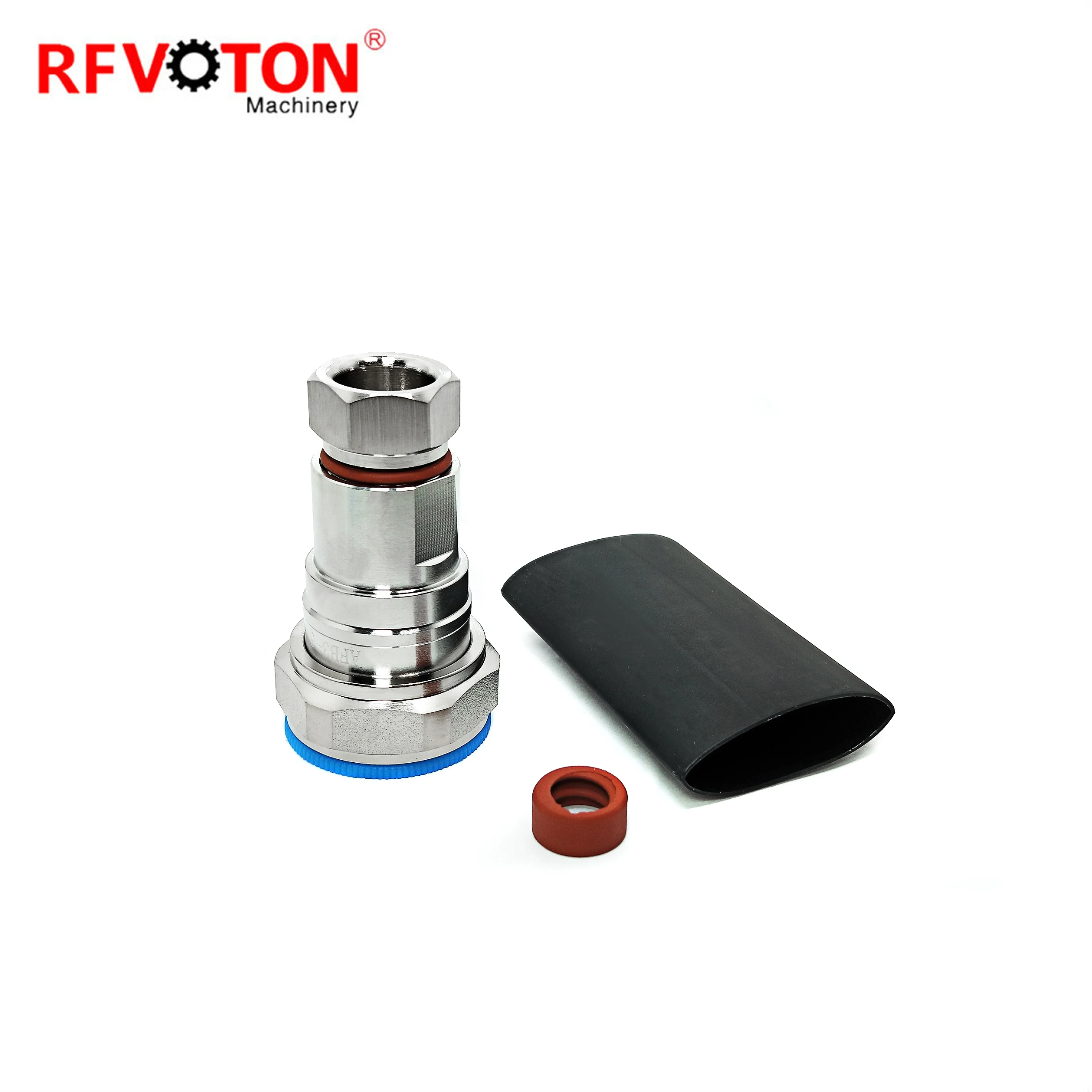RF ကောဘီလ်ချိတ်ဆက်မှုများ – RF ကောဘီလ်ချိတ်ဆက်မှုများသည် နံပါတ်များအတွက်နှင့် ပိုမို ကောဘီလ်များအတွက်အသုံးပြုသည်။ ဒီသေးငယ်တဲ့လောင်းပစ္စည်းတွေဟာ သင့်ရဲ့ထင်မြင်တဲ့အရွယ်အစားနှင့်ပုံစံတွေအားလုံးရှိပြီး သင့်ထင်မြင်မှုထက်ပိုသောအရွယ်အစားတွေလည်းရှိနိုင်ပါတယ်။ ဒါပေမယ့်၊ ဒီတွေအားလုံးကိုကြိုးပမ်းဖို့မလိုပါဘူး၊ ကျွန်တော်တို့ဟာ သင့်အား RF ကောဘီလ်ချိတ်ဆက်မှုများ၏မျိုးမျိုးကို ဖော်ပြပေးမည်ဖြစ်ပါတယ်။ မျိုးတစ်ခုက SMA ဖြစ်ပြီး၊ SubMiniature version A ဆိုတဲ့ဝေါဟာရ၏အတိုကောက်ဖြစ်ပြီး၊ ဒါဟာအသေးစိတ်ရဲ့အရွယ်အစားနှင့် လှုပ်ရှားနိုင်သောဒီဇိုင်းဖြင့် အသုံးပြုသောအခြေအနေများအတွက်အသုံးပြုသည်။ ဒုတိယမျိုးက SMB ဖြစ်ပြီး၊ SubMiniature version B ဖြစ်ပြီး၊ SMA နဲ့တူတယ်လို့လည်း ဒီမှာ snap-on ချိတ်ဆက်မှုရှိပါတယ်။ နောက်ထပ်တစ်မျိုးက BNC ဖြစ်ပြီး၊ Bayonet Neill–Concelman ဆိုတဲ့ဝေါဟာရ၏အတိုကောက်ဖြစ်ပြီး၊ ကိုက်ညီသောလေးများနှင့်အတူ coaxial ကောဘီလ်များတွင် ရေဒီယိုဖျော်ဖြေမှုအသုံးပြုမှုများအတွက်အသုံးပြုသည်။ ပိုမိုအခြားချိတ်ဆက်မှုများလည်းရှိပြီး၊ ဒီမျိုးမျိုးကို အသုံးပြုမှုအရ ပုံစံများအတိုင်း ဒီဇိုင်းများအတိုင်း ဒီဇိုင်းဆွဲထားပါတယ်။ ထို့ပြင်၊ မှားယွင်းသောချိတ်ဆက်မှုကိုရွေးချယ်ခြင်းမှာ အရေးကြီးပါတယ်၊ ဘာဖြစ်လို့လဲဆိုတော့ မှားယွင်းသောချိတ်ဆက်မှုက အခြားအချက်များကို ဖြစ်ပေါ်စေနိုင်ပါတယ်၊ ဥပမာအားဖြင့် လောင်းများနှင့် လုပ်ဆောင်မှုကြောင့်။ Coaxial ကောဘီလ်ကိုဘယ်လိုပြီးစီးမလဲ? အစောပိုင်းမှာ ရှုပ်ထွေရှုပ်ပြီးဖြစ်ပါတယ်၊ ဒါပေမယ့် အမှန်တကယ်က များစွာသောကောဘီလ်ကုမ္ပဏီတွေက coaxial ကောဘီလ်ကိုပြီးစီးဖို့အတွက် အရှုံးလွန်တဲ့နည်းလမ်းကိုသုံးပါတယ်။ Coaxial ကောဘီလ်ကိုပြီးစီးခြင်းဟာ အများအားဖြင့် RF ကောဘီလ်ချိတ်ဆက်မှုကို ကောဘီလ်အဆုံးမှာချိတ်ဆက်ဖို့အတွက်ပုံစံဖြစ်ပြီး၊ ဒီမှာတော့ အခြားလောင်းတစ်ခုနှင့်ချိတ်ဆက်ဖို့လွယ်ကူပါတယ်။
ကိုအက်ဆီယယ်ကဘာလ်၏ အချိန်မှားကို ပြီးစီးရန် သင့်တွင် အခြေခံအတိုက်အတာများ၊ ကွဲလွဲသော ဖိုင်များနှင့် လှုပ်ရှားသော ပိုင်းကို လိုအပ်ပါသည်။ အပြင်ဆင်ထားသော အခြေအနေကို ဖြာခြင်းနှင့် အလျင်းကို ထုတ်ဖော်ပါ။ ဒီဇိုင်းမှာ အဆောက်အအုံတွင် အသုံးပြုသော ကွဲလွဲသော ဝါရှင်များကို အတူတွဲပြီး ဆုံးဖြတ်သော အဆောက်အအုံကို ဆက်သွယ်ပါ။ ဒီမှာ သင့်သည် ချိတ်ဆက်သော အရာကို လှုပ်ရှားပြီး အတွင်းရှိ ခြောက်ကို ပြန်လည်လှုပ်ရှားပါ။
ကိုအက်ဆီယယ်ကဘာလ်များကို အဆုံးသတ်ခြင်းအတွက် လုပ်ဆောင်ချက်ကို သိရှိခြင်းသည် အလက်ထောက်များ သို့မဟုတ် ဆက်သွယ်ရေးကိရိယာများနှင့် အလုပ်လုပ်ခြင်းတွင် အမြဲတမ်းသော အမြတ်တံဆိပ်ဖြစ်ပါသည် - အကောင်းဆုံးဖြစ်ရန် အစီရင်ခံမှုများကို လုပ်ဆောင်ပါ။
ကုမ္ပဏီတစ်ခုသည် RF အကိုင်းစနစ်တစ်ခုကို ဆောက်ထားရန် ယူဆထားပါက၊ အထူးသဖြင့် ကေဘားလင်နှင့် အခြေခံအချက်များအတွက် ကျေးဇူးဟာ အမြဲတမ်း ကြီးမားသော ကြောက်ရွှင်းဖြစ်ပါသည်။ ဒါကြောင့် သင့်အတွက် မှန်ကန်သော RF ကေဘားလင်ချုပ်ကို ရွေးချယ်ခြင်းမှ ပိုမိုသော အကျိုးသက်ရောက်မှုရှိပါသည်။ ဒါကြောင့် သင့်အတွက် အကောင်းဆုံး အကျိုးအမြတ်ကို ရွေးချယ်ရန် အတွက် အချို့သော ပြောင်းလဲမှုများကို အကြံပြုပါမည်။
သင့်ရဲ့ ပထမဆုံး ဖြန့်ချီမည့် လုံးလောင်းကို စဉ်းစားပါ။ COPPER Thin Cables (75 Ohm Impedance) - မတူညီသော ချက်ချင်းများသည် မတူညီသော အချိန်အကြာများတွင် လုပ်ဆောင်ရန် ဒီဇိုင်းထားသည်၊ ထိုအချိန်အကြာတော့ ချက်ချင်းက လိုအပ်ချက်များကို မှန်ကန်ပြီးမလားဆိုတာကို စဉ်းစားပါသည်။ ထို့နောက် သင့် ကဗျားနှင့် ချက်ချင်းတို့ရဲ့ impedance ကို စဉ်းစားပါ- impedance တွေကို မှန်ကန်စွာ တူညီစေခြင်းဟာ လုံးလောင်းပerte သို့မဟုတ် noise ကို ရှောင်ရှားမှုကို ကာကွယ်ရန်အတွက် အရေးကြီးသော ပိုင်းဖြစ်သည်။ နောက်ဆုံးမှာ သင့်ကဗျားကို အသုံးပြုမည့် ပরিবেশကို စဉ်းစားပါ။ အသုံးပြုမည့် ချက်ချင်းများကို waterproof သို့မဟုတ် dustproof လိုအပ်နိုင်ပါသည်။ ချို့တွေမှာ extreme temperatures၊ vibration၊ ground movement၊ constant motion စသည်တို့အတွက် အခြားအရာတစ်ခုလိုအပ်နိုင်ပါသည်။
ဒီမှာ အကူးဆင်ဆုံးချက်သည် RF ကေဘီလ်ချိတ်ဆက်မှုနှင့် ထို့ကို မှန်ကျသောပုံစံဖြင့် တည်ဆောက်ခြင်းဟာ ဆက်သွယ်ရေးပြဿနာများ၊ လျှို့ဝှက်မှု၊ အခြားအရာများဖြင့် ပါဝင်သော အခြားအရာများကို ရှာဖွေရန် အလွယ်တကူဖြစ်သည်။ ကေဘီလ်ချိတ်ဆက်မှုတည်ဆောက်ခြင်းအတွက် အရေးကြီးသော အဆင့်များ:
ချိတ်ဆက်မှုသည် ကေဘီလ်နှင့် တိုက်ရိုက်မှန်ကျသော ပေါင်းစပ်မှုဖြင့် လှည့်ပတ်မှု (ထို့ကြောင့် မှန်မှုများ) ကို ရှောင်ရှားရန် အားပေးပါသည်။ ထို့နောက်တွင် သင့်ကေဘီလ်ချိတ်ဆက်မှုသည် ပြင်းထန်သော အခြေအနေဖြင့် လျှို့ဝှက်မှုနှင့် အခြားအရာများကို တိုးပွားစေရန် အားပေးပါသည်။ အခြားသော အသုံးပြုမှုများကို အသုံးပြုခြင်းဖြင့် သင့်ငွေကို လျော့နည်းစေနိုင်ပါသည်။ ဆက်သွယ်မှုပြဿနာများကို ပြောင်းလဲခြင်းဖြင့် သင့်အလုပ်ကို ပြုလုပ်ရန် အခက်အခဲများကို ရှာဖွေရန် အလွယ်တကူဖြစ်သည်။ အစောပိုင်းတွင် ချိတ်ဆက်မှုနှင့် ကေဘီလ်တို့ကို ရှုံးလွှာများဖြင့် စစ်ဆေးရန် လိုအပ်ပါသည်။
RF ကောင်တွဲချိတ်ဆက်မှုအကြောင်းပြောဆိုသည့်အခါ၊ အရေးကြီးသောလုပ်ငန်းစဉ်မှာ အရည်အချင်းနှင့် မှန်ကန်မှုပေါ်မူတည်၍ဖြစ်သည်။ သင်သည်လုပ်ရမည့်အချက်များမှာ:
အမြဲတမ်းအထူးသတ္တုများကိုသုံးပါ။ အရေးကြီးမဟုတ်သောအပိုင်းများသည် ဆက်သွယ်မှုများကိုဆိုင်းပါးစေပြီး လုံးဝဆိုင်းပါးသောလောင်းဆိုင်းမှုကိုဖြစ်ပေါ်စေနိုင်သည်... ထုတ်လုပ်သူ၏အကြံပြုသောဖော်ပြချက်များကိုလိုက်နာပါ: ဒီဇိုင်းများသည် သင့်အား အမှားမရှိသောဆက်သွယ်မှုကိုပေးသောကြောင့်ဖြစ်သည်။ ကိရိယာသို့မဟုတ်စနစ်ကိုထုတ်လွှင့်မည်မဟုတ်ပါက၊ ဒီဇိုင်းကိုတစ်ခုခုစီမှာပြင်ဆင်ရန်မဟုတ်ဘဲ ပัญหาတစ်ခုရှိပါကသာတွင် စစ်ဆေးပါ။
အတိတ်အတွင်းမှာ RF ကောင်တွဲချိတ်ဆက်မှုများသည် အားလုံးသောလျှပ်စစ်သို့မဟုတ်အီလက်ထရွန်စ်ဆက်သွယ်မှုစနစ်တွင် လျှပ်စစ်ကိုထွက်လာစေသော အခြေခံအစိတ်အပိုင်းများဖြစ်သည်။ အသုံးပြုသူသည် မည်သည့်အကြောင်းအရာများကိုအသုံးပြုသင့်သည်၊ ဘယ်အကြောင်းအရာများကြောင့်သူသည်အသုံးပြုသင့်သည်၊ မည်သည့်ချိတ်ဆက်မှုသို့ချိတ်ဆက်သင့်သည်ဆိုသည်ကို မှန်ကန်စွာသိရှိပါက မှန်ကန်သောနှင့်မှန်ကန်သောဆက်သွယ်မှုကိုရရှိနိုင်ပါသည်။ အမှန်တကယ်တွင် မှန်ကန်သောအထောက်အကူများနှင့်အရေးကြီးသောလုပ်ငန်းစဉ်များကိုလိုက်နာပါက RF ကောင်တွဲချိတ်ဆက်မှုများတွင်ကောင်းမွန်သောအဖြေများကိုရရှိနိုင်ပါသည်။
အစမှာ ရှုပ်ထွေးလာတဲ့ အချက်တစ်ခုဖြစ်နိုင်ပါတယ်။ ဒါပေမယ့် မိုက်ဘာ ကုမ္ပဏီများဟာ ကိုက်ဆိုင်း ကော်ဘာလ်ကို ပိတ်ဆို့ဖို့အတွက် သိပ်ရှင်းလွယ်တဲ့ လုပ်ငန်းစဉ်တစ်ခုကို သုံးနေတယ်။ ကိုက်ဆိုင်း ကော်ဘာလ်ကို ပိတ်ဆို့ဖို့ဆိုတာက အခြား ကိရိယာတစ်ခု သို့မဟုတ် အခြား ကော်ဘာလ်တစ်ခုနဲ့ ကူးသွားဖို့အတွက် ကော်ဘာလ်ရဲ့ အဆုံးတွင် RF ကော်ဘာလ် ချိတ်ဆက်ခြင်းကို ချိတ်ဆက်ခြင်းဖြစ်ပါတယ်။
ကိုက်ဆိုင်း ကော်ဘာလ်ရဲ့ အဆုံးကို အောင်မြင်စွာ ပြီးစီးဖို့ သင့်တော်တို့ဟာ ချိတ်ဆက်ခြင်း၊ ကော်ဘာလ် ဖြတ်ခြင်းနှင့် ချိတ်ဆက်ခြင်းအတွက် အခြေခံလုပ်ငန်းများ အသုံးပြုရပါမည်။ ပြင်ပုံကို ဖြတ်ပြီး ကားဝါးကို မြင်သာစေပါ။ ထို့နောက် ကားဝါးကို ပြီးသားမှာမှ ခွဲထုတ်ပြီး သူတို့ရဲ့ ခွဲခြားမှုကို လှုပ်ပါ။ ထို့နောက် ချိတ်ဆက်ခြင်းကို ပြင်ပုံပြင်ပြီး အလွန်ကို ချိတ်ဆက်ပြီး ကားဝါးကို ပြုပြင်ပါ။
ကိုက်ဆိုင်း ကော်ဘာလ်များကို ပိတ်ဆို့ဖို့အတွက် အသုံးပြုနိုင်သော ကျွမ်းကျင်မှုဟာ အီလက်ထရွန်စ် သို့မဟုတ် ဆက်သွယ်ရေးကိရိယာများနဲ့ အလုပ်လုပ်နေတဲ့ လူများအတွက် အသုံးဝင်တဲ့ ကျွမ်းကျင်မှုဖြစ်ပြီး အလုပ်လုပ်ဖို့အတွက် လွယ်ကူစွာ သင်ယူနိုင်ပါတယ်။

ကာဘလင် ထုတ်ကုန်အရေအတွက်မြင့်သည်ဟု ခံစားရပါက RF ကာဘလင် ဆက်သွယ်မှုကို မှန်ကန်သောအတိုင်းရွေးချယ်ခြင်း၏ အကျိုးသက်ရောက်မှုကို အများကြီးဖြင့် အမှားယူချက်မရှိပါ။ ဒါကြောင့် အောက်ပါသည် သင့်အတွက် အကောင်းဆုံး အကျိုးဝင်သော ဇာတ်ကောင်းကိုရွေးချယ်ရန် အခြေခံအကြောင်းအရာများဖြစ်ပါသည်။
ပထမဆုံး သင့်အား ထုတ်လွှင့်မည့် လောင်းရောင်းကို ခံစားပါ။ ကျွန်းများသည် လောင်းရောင်းအကျိုးအတိုင်းအတွင်းတွင် လုပ်ဆောင်ရန် ဒီဇိုင်းထုတ်ထားသည်၊ ထိုလောင်းရောင်းအတွက် လိုအပ်သော လိုအပ်ချက်များကို ကျွန်းတစ်ခုက အကောင်းဆုံးဖြစ်စေရန် ရွေးချယ်ရန်လိုအပ်ပါသည်။ ဒုတိယအကြောင်းအရာအဖြစ် ကာဘလင်နှင့် ဆက်သွယ်မှုအကြောင်းအရာများ၏ လောင်းရောင်းကို ကြည့်ရှုပါ။ လောင်းရောင်းများကို ညီမျှစေခြင်းသည် လောင်းရောင်းကွယ်လွှဲမှုသို့မဟုတ် အသံကွယ်လွှဲမှုကို ကန့်သတ်ရန် အခြေခံအကြောင်းအရာဖြစ်သည်။ နောက်ဆုံးအကြောင်းအရာအဖြစ် သင့်အား ကာဘလင်ကို အသုံးပြုရန် ဘယ်နေရာမှာလဲဆိုတာကို ခံစားပါ။ အချို့သော အသုံးပြုမှုများတွင် ရေကို ကန့်သတ်နိုင်သော သို့မဟုတ် အိမ်းသောကို ကန့်သတ်နိုင်သော ဆက်သွယ်မှုများလိုအပ်ပြီး အခြားသော အသုံးပြုမှုများတွင် အားကစားသော အပူချိန်များ၊ ပြင်းထန်မှု သို့မဟုတ် လျင်မြန်စွာ လှုပ်ရှားနေသော ဆက်သွယ်မှုများလိုအပ်ပါသည်။

RF ကောဘီလ်ချုပ်တစ်ခုကို မှန်ကန်စွာ တည်ဆောက်ခြင်းသည် ရောင်းအချက်များအဖြစ် လျှော့ချမှု၊ ထိခိုက်မှုနှင့် အသံများ၏ ပြဿနာများကို ရှေ့ဆောင်ရန်အတွက် အရေးကြီးဖြစ်သည်။ ကောဘီလ်ချုပ်ကို တည်ဆောက်ရန်အတွက် အရေးကြီးသော ညွှန်ကြားချက်များ:
ပထမဆုံးတွင်၊ ချုပ်သည် မြောက်သောအခါ လေးများ၊ သို့မဟုတ် လေးများမရှိဘဲ ကောဘီလ်တွင် ချိတ်ဆက်ထားသည်ဟု သေချာစွာ စစ်ဆေးရန် လိုအပ်သည်။ ဒါပေမယ့် ချုပ်သည် လေးများမရှိဘဲ ရွှေ့ပြောင်းမှု (ထို့ကြောင့်: မှန်ကန်မှုများ) ကို ရှေ့ဆောင်ရန်အတွက် အကူအညီပေးသည်။ နောက်ပိုင်းတွင်၊ ကောဘီလ်ကို ပြီးစီးစွာ ပြီးပြည့်စွာ ချိတ်ဆက်ထားသည်ဟု စစ်ဆေးရန် လိုအပ်သည်။ မှားယွင်းသော ကောဘီလ်ကို ချိတ်ဆက်ခြင်းသည် ရောင်းအချက်များနှင့် အသံများ၏ လျှော့ချမှုကို ဖြစ်ပေါ်စေရန် ဖြစ်သည်။ တည်ဆောက်ရေးအတွင်းတွင် သင့်အတွက် မှန်ကန်သော အကိုင်းအတိုင်းကိုသာ အသုံးပြုရန် လိုအပ်သည်။ မှားယွင်းသော အကိုင်းအတိုင်းများဖြင့် ကောဘီလ်သို့မဟုတ် ချုပ်တွင် ဆောင်းပါးများကို ဖြစ်ပေါ်စေရန် ဖြစ်သည်။ သင့်အား စတင်ရန်အတွက် ချုပ်နှင့် ကောဘီလ်တို့ကို ရှုံးကြည့်ရန် လိုအပ်သည်။ အနည်းဆုံးသော မျှော်လင့်မှုများကို တည်ဆောက်ပြီးနောက် ချိတ်ဆက်မှုပြဿနာများကို ဖြစ်ပေါ်စေနိုင်သည်။

RF ကောဘီလ်ချုပ်များနှင့် ဆက်သွယ်ရန်အတွက် အကောင်အထည်ဖော်ရန် အရေးကြီးသော အကြောင်းအရာများအဖြစ် အရောင်းနှင့် သိပ္ပံရေးကို ထိန်းသိမ်းရန် လိုအပ်သည်။ သင့်အားလုံးသည်:
အရည်အချင်းမြင့်သော ကေဘီလ်များနှင့် ဆက်သွယ်မှုပစ္စည်းများဖြင့် စတင်ပါ။ ကြော်ငြာသော ပစ္စည်းများသည် ဆက်သွယ်မှုများကို ဆိုးရွားစေ၊ လောင်းထွက်မှုအား ပိုမိုဆေးကြားစေနိုင်ပါသည်... ထုတ်လုပ်ရေးသူ၏ အကြံပြုချက်များကို အသုံးပြုပါ။ ဒီဇိုင်းများသည် အသစ်တည်ဆောက်ရန် လုပ်ငန်းစဉ်အတွက် မှန်ကန်သော အကြောင်းအရာများကို ပေးပါသည်။ အမှားမရှိသော ဆက်သွယ်မှုရရှိရန် အကြံပြုချက်များကို လိုက်ညီစေရန် အရည်အချင်းများကို လုပ်ဆောင်ပါ။ ပစ္စည်းသို့မဟုတ် စနစ်ကို အသုံးပြုခြင်းမှ ကြားမှာ လောင်းထွက်မှုကို စစ်ဆေးပါ။
အတို့အတိုင်း ပြောရင် RF ကေဘီလ်ဆက်သွယ်မှုများသည် လေ့လာမှုအား ဝင်ရောက်သွားသော အခြေအနေများကို အလွယ်တကူ ဆက်သွယ်ပေးသည့် အရေးကြီးသော အချက်များဖြစ်သည်။ အမျိုးမျိုးသော အမျိုးအစားများနှင့် ရည်ရွယ်ချက်များကို အကောင်အထည်ဖော်ပြခြင်း၊ အသုံးပြုမည့် ဆက်သွယ်မှုကို ရွေးချယ်ခြင်းများသည် မှန်ကန်သောနှင့် လေးမှန်သော ဆက်သွယ်မှုကို ချိတ်ဆက်ရန် အရေးကြီးသည်။ အကောင်အထည်ဖော်မှုများနှင့် အကောင်းဆုံး လုပ်ဆောင်ချက်များကို လိုက်ညီစေခြင်းဖြင့် သူတစ်ယောက်ကို သိရှိမှုကို ပိုမိုတိုးတက်စေရန် ဖြစ်ပါသည်။
Zhenjiang Voton Machinery Co., Ltd. သည် RF adapter, antennas, connectors surge protectors, passive parts တို့၏ဝန်ဆောင်မှု၊ R and D၊ ရောင်းချမှုတွင် ပြောင်းလဲခြင်းများကို အကျိုးပြုသည့် high-tech enterprise ဖြစ်သည်။ rf cable connectors အတွက်လိုအပ်ချက်များအရ အကိုင်းအကာအတွင်း အသုံးပြုနိုင်သည့် စီမံခန့်ခွဲမှု၊ စစ်ဆေးခြင်း၊ အကောင်အထည်ဖော်ခြင်းများကိုပေးဆောင်ပါသည်။
ဝန်ဆောင်မှုများကို သင့်လိုချင်သည့်အတိုင်း ပေးပို့ပါသည်။ ဥပမာအားဖြင့် ရဲ့ စမ်းသပ်မှုဝန်ဆောင်မှု၊ ထုတ်ကုန် rf ကေဘယ်ချိတ်ဆက်ခြင်းများ၊ ပြင်ဆင်မှုဝန်ဆောင်မှုများပါဝင်သည်။ SMA၊ N နှင့် F မော်ဒယ်များအတွက် coaxial ချိတ်ဆက်ခြင်းများကို ပြုလုပ်ပါသည်။ BNC၊ TNC နှင့် QMA ပါဝင်သည်။ RF ကိုင်းတွင် အဓိကသမားအဖြစ် ပူးပေါင်းလာမည့်အတွက် ကျွန်ုပ်တို့သည် ကိုယ်ပိုင်အတွက် ပြင်ဆင်နေပါသည်။
ISO9001၊ CE RoHS၊ FCC UL IP68 စသည့် သို့မဟုတ် အမှတ်များကို ရရှိခဲ့ပါသည်။ ထုတ်ကုန်များအတွက် ပြုလုပ်ထားသော ပိုင်ခွင့် ၁၈ ခုကို ခိုင်မာစေပါသည်။ ဂျင်ဆွဲပြည်နယ်တွင် High-Tech Enterprise အဖြစ် အသိအမှတ်ပြုခံရပါသည်။ သင့်လုပ်ငန်းအတွက် rf ကေဘယ်ချိတ်ဆက်ခြင်းများ၏ လိုအပ်ချက်များအတိုင်း စမ်းသပ်ခဲ့ပြီး သိမ်းဆည်းထားသော ထုတ်ကုန်များသည် အမြင့်ဆုံးသို့မဟုတ် အရည်အချင်းများဖြင့် ပြုလုပ်ထားသည်။
၁၄၀ ကျော် rf ကေဘယ်ချိတ်ဆက်ခြင်းများဒေသများသို့ ထုတ် khẩuပါသည်။ ၁၄၀ ကျော်နိုင်ငံများနှင့် ဒေသများသို့ ထုတ်ကုန်များကို ထုတ် khẩuပါသည်။